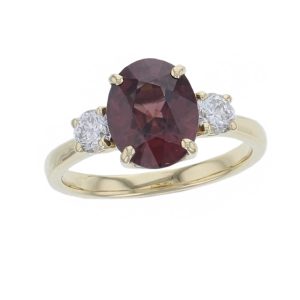-
Colour
Colourless when pure, this zirconium silicate takes on various shades due to impurities or heat treatment. Zircon comes in a range of colours, including blue, green, brown, champagne, cinnamon, coffee, cognac, honey, yellow, orange, rose and red. Rose and rose-orange zircon usually come from Tanzania, and orange to orange-brown zircon from Cambodia.
The most valuable colours of zircon are blue, bright red, and green. Blue zircon is the most popular. Blue zircon occurs in all shades from pale to dark but medium dark, pure blue stones have the most value. Due to pleochroism, blue zircon can look greenish from certain angles. Green zircon is very rare and typically very expensive.
-
Cut & Clarity
In general, zircon is transparent to translucent and has a brilliant, vitreous (glass like) sheen when polished.
Zircon has very high luster and dispersion, giving it lots of brilliance and fire (flashes of multicoloured light). These characteristics mean that colourless zircon has been mistaken for diamond in the past. Zircon has double refraction so facet junctions can appear doubled from certain angles making it appear fuzzy. This characteristic is one of the ways to distinguish zircon from diamond or cubic zirconia as they are both singly refractive. The highest grade zircons are cut to minimize double refraction.
Zircon is often eye-clean. Gems with noticeable inclusions are less valuable.
Coloured stones are usually brilliant or step cut while colourless stones are most often brilliant cut to show off their brilliance. Round stones are usually given a standard round brilliant cut, with an extra row of facets at the edges. The most popular shapes include ovals, rounds, pears, octagons and fancy trilliants.
-
Health Benefits
In the Middle Ages, this gem was thought to induce sound sleep, drive away evil spirits and promote prosperity, honour and wisdom.
Used for its spiritual and physical healing properties, it represents happiness, chastity, purity and positive energy. Zircon is associated with all the chakras and can combine their strengths by aligning them.
Zircon enhances attractiveness and popularity so it’s an excellent choice for those involved in creative careers and entertainment such as music, acting, public relations, event management, artists and writers.
-
Care
Zircon has good hardness and durability (7.5 Moh’s scale ). Heat treated zircon can be brittle and sensitive to knocks and pressure and have the tendency to wear along facet edges so should be limited to protective style settings or occasional wear rings.
Blue zircons can change colour to brown when exposed to ultraviolet radiation in tanning beds or under ultraviolet lamps used to cure acrylic fingernail adhesives. Sometimes the colour can be restored by exposure to low wattage incandescent light.
Zircon gems are immune to acid attack but like most gem jewellery cleaning is best done by using warm soapy water and scrubbing around the gem with soft toothbrush. Be sure to rinse your stones well using warm water to remove soapy residue.
Always remove zircon jewelry when engaging in any type of physical activity, including household chores, exercise or sports. When storing zircon jewellery, it is best to wrap them individually in a soft cloth or place them separately from one another inside a fabric-lined box to prevent scratches and fractures from other jewellery.

Zircon
Zircon is one of the birthstones for December and an alternate gem for the 4th wedding anniversary.
Zircon has been treasured as a gemstone for nearly 2000 years. It occurs in all shades of the colour spectrum and is one of the densest gemstones. It will look smaller than other gems of the same weight. Being 50% denser than diamond a 1.50ct zircon will look similar in size to a 1.00ct diamond.










